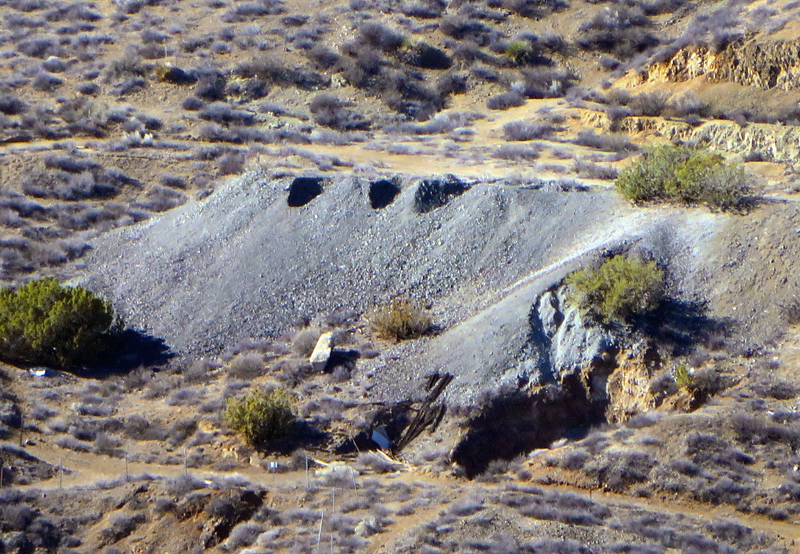|
|
Acton, California

Click image to enlarge
December 14, 2013 — Tailings of the Red Rover gold mine in Acton. The view is to the west, as seen from the hilltop behind (west of) the Governor mine. The Red Rover was one of several Acton gold mines owned in the late 1880s by California Gov. Henry Gage. At the time, it was one of the most productive gold mines in Los Angeles County. The Red Rover sits on what is now BLM land on the west side of Red Rover Mine Road, about a half-mile north of SR-14 (and just south of Fairlane Street). The mining claim, which covers 69 acres, is held by an Acton resident who has owned it since about the early 1980s. According to John Robinson, noted historian of the San Gabriel Mountains, the Red Rover actually predated Gage. Robinson (1973:27,30) writes: The Red Rover Mine ... was first worked by Mexicans in the early 1870s, using arrastres. It is said that for several years, the gold-bearing ore from the Red Rover was hauled by oxen to San Pedro, then shipped to Mexico for processing. Around 1882, the Red Rover came under the control of American miners, led by E.B. Millar. A 200-foot shaft was dug which tapped a rich vein of gold-bearing quartz and for a number of years the Red Rover enjoyed bonanza times. In 1888 the company erected a 10-stamp mill below the mine and conveyed the ore to mill via a 400-foot tramway. By 1892, a new vertical shaft was down 400 feet, with several levels being worked. In 1894, according to the California State Mining Bureau's annual report, the Red Rover was the most productive mine in the district. Three other mines were operated by the company — the John Logan, the Earl, the Topeka — but none of them approached the production of the Red Rover. [...] The No. 2 gold producer in the county was the Red Rover [after the Governor mine on the next hilltop to the east], with a total yeild of $550,000. The Red Rover was inactive from 1897 until 1912, when it was briefly worked, then inactive again until 1931, when it was acquired by Francis Gage [son of Henry Gage] and his Governor Mines Co. During the 1930s the mine was worked in conjunction with the Governor Mine, yielding good amounts of gold at various intervals. The ore, averaging a modest $10 per ton in gold, was milled at the Governor mill in Acton. The Red Rover closed down in 1940 and has not been worked since. President Franklin D. Roosevelt had banned the private ownership of gold in 1934, and World War II brought additional restrictions. The government shut down gold mining operations nationwide in 1942. The Red Rover's shafts — of which it had six, varying in depth from 100 to 650 feet — were filled in. There's still some gold in them-thar hills, but not in quanties or concentrations that were profitable to mine when the spot price of gold hovered in the $300 to $400-per-ounce range throughout the 1980s, 1990s and 2000s. When the spot price topped $550 in 2006, a group of entrepreneurs, in cooperation with the claimholder, started making plans to reopen the Red Rover under the assumption that the high sales price would justify the otherwise prohibitive expenditure. Accrording to the company (Red Rover Mine Inc.): "Now [2006], we have concluded that the price of gold has made the expected profitability of the mine so profound that the reopening of the mine can no longer be put off." The spot price of gold passed $1,500 in 2011-2012. But as of late 2013, the reopening hasn't happened.
LW2538b: 19200 dpi jpeg from digital image by Leon Worden. |
Related Categories:
Miners & Ore Body 1890
Henry Gage & Ed Brough n.d.
Letter: Brough Orders Ties 1910
Overview 1911
5-Stamp Mill 1911 x2
New Shaft House 1911
12-14-2013 x7
|
The site owner makes no assertions as to ownership of any original copyrights to digitized images. However, these images are intended for Personal or Research use only. Any other kind of use, including but not limited to commercial or scholarly publication in any medium or format, public exhibition, or use online or in a web site, may be subject to additional restrictions including but not limited to the copyrights held by parties other than the site owner. USERS ARE SOLELY RESPONSIBLE for determining the existence of such rights and for obtaining any permissions and/or paying associated fees necessary for the proposed use.












